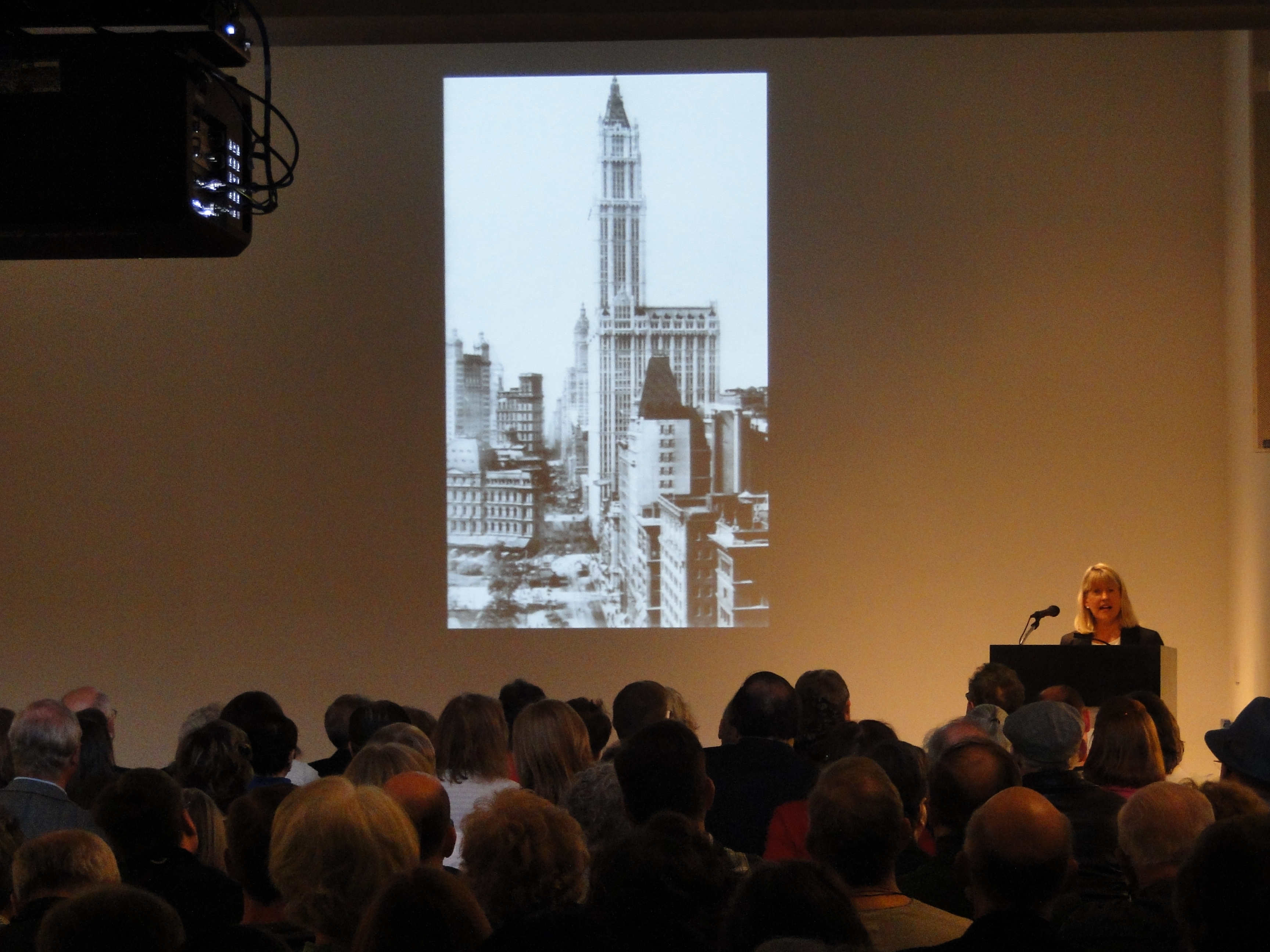by: Julie Engh Assoc. AIA
Presented as part of “Woolworth Week,” a celebration of the Woolworth Building’s centennial, on 04.22.13 author Gail Fenske examined how architect Cass Gilbert and owner Frank W. Woolworth created the landmark masterpiece with a talk at the Center for Architecture. Fenske, a well-known Gilbert scholar and author of the book The Skyscraper and the City: The Woolworth Building and the Making of Modern New York, described how New York City established itself by 1900 as the nation’s center of commerce with its subway systems, tunnels, great train stations, bridges, and other engineering feats built at unprecedented speed. Rapid technological modernization and the advent of cheaper, colorful newspaper printing contributed to a new urban experience, that of a commercial culture in perpetual change.
In this city caught in the throes of modernity, Woolworth commissioned fanciful storefront designs and orchestrated theatrical opening extravaganzas. In 1901, to commemorate the anniversary of opening his first five-and-dime store, he opened his first Woolworth Building in Lancaster, PA. Modeled on new department stores in Paris, it transformed the undesirable area into a veritable attraction.
As Woolworth’s empire grew, he picked a lot across Broadway from the southwest corner of City Hall Park as the site for a monumental Woolworth Building. Cass Gilbert’s ability to create vivid pictorial identities for major institutions, as evidenced by his Minnesota State Capital and U.S. Customs House, caught Woolworth‘s eye. Gilbert’s other New York skyscrapers – the Broadway Chambers Building and West Street Building – proved he was comfortable building to great heights.
According to Fenske, both Gilbert and Woolworth aspired to design and build a great architectural monument. Gilbert modeled his original designs on the Victoria Tower at the English Houses of Parliament. As Woolworth pushed Gilbert to go higher and higher, what began as a 20-story speculative office building became a 750-foot tower. Gilbert relied heavily on the structural expertise of Gunwald Aus, who had proposed inventive solutions for Gilbert’s earlier projects. Aus complained about the conservatism of the NYC Building Code, which required incredible amounts of structural steel bracing. To achieve the Woolworth’s light, diaphanous elevations, Aus devised a wind bracing system, including costly systems of portal arch wind bracing. Louis Horowitz of the Thompson-Starrett Company provided the skilled workforce, including caisson workers sinking some of the deepest foundations seen at the time. The 180 structural iron workers who erected and riveted the Woolworth Building’s frame set a speed record by completing the task in less than nine months.
Its famous terra-cotta panels were noted by Susan Tunick, president of The Friends of Terra Cotta, who was in attendance at the lecture. The Friends’ publication “Highest of the Hand-Made Buildings” was on-hand at the Center and is available for purchase here.
Woolworth published simultaneous stories on May 4, 1911, in the New York Times, World, Herald, and Tribune newspapers announcing the “Woolworth Building will be World’s Greatest Skyscraper.” His flair for spectacle culminated in the building breathtaking opening on April 24, 1913. President Woodrow Wilson pressed a button in his office and telegraphically wired to the Woolworth’s power plant; 80,000 incandescent bulbs in the skyscraper’s interior leapt on at once. The images of the glowing tower were transmitted to the Eiffel Tower in Paris, then to all hubs in Europe, heralding the newly-powerful role of the skyscraper in the city.
With 55 floors of speculative office space in a city generally considered at the time as being overbuilt, Woolworth resolved to create space fit for high style consumption. The building’s evocative and luxurious interiors emulated European settings for elite interaction and social display. An interior shopping arcade, giant barbershop, restaurant, swimming pool, and observatory provided tenants spaces for entertainment and amusement. Gilbert and Woolworth enhanced the traditional office experience by weaving architectural theatrical settings throughout the building, creating a respite from the city’s realities. Woolworth emphasized service, insisting the building employ the very best of plumbing, fire protection, and ventilation systems.
High-speed elevators whisked visitors to the tower’s pinnacle observatory 750 feet in the sky. Drawing more than 100,000 people from 60 countries annually, the observatory further cemented the building’s status as an international icon. Check out the continued celebration at the Skyscraper Museum with the exhibit “The Woolworth Building @ 100,” on view through July 14.
Julie Ann Engh, Assoc. AIA, LEED AP, works in the Architecture Department at Highland Associates, and currently serves as the 2013 AIANYS Associate Director.
Event: The Woolworth Building: The Making of a New York Landmark
Location: Center for Architecture, 04.22.13
Speaker: Gail Fenske, Author, The Skyscraper and the City: The Woolworth Building and the Making of Modern New York (University of Chicago Press, 2008)
Organizer: AIANY Historic Buildings Committee and the Cass Gilbert Society
Sponsor: The Skyscraper Museum








